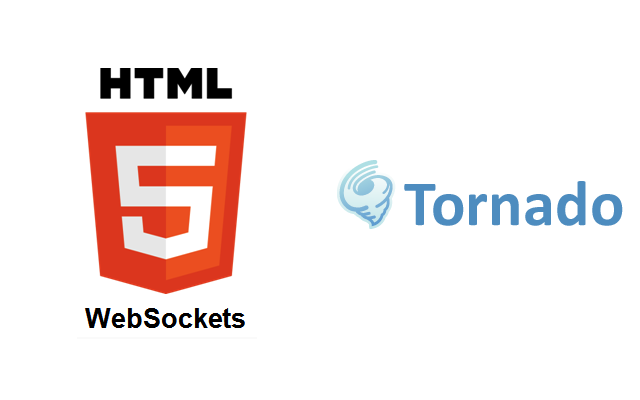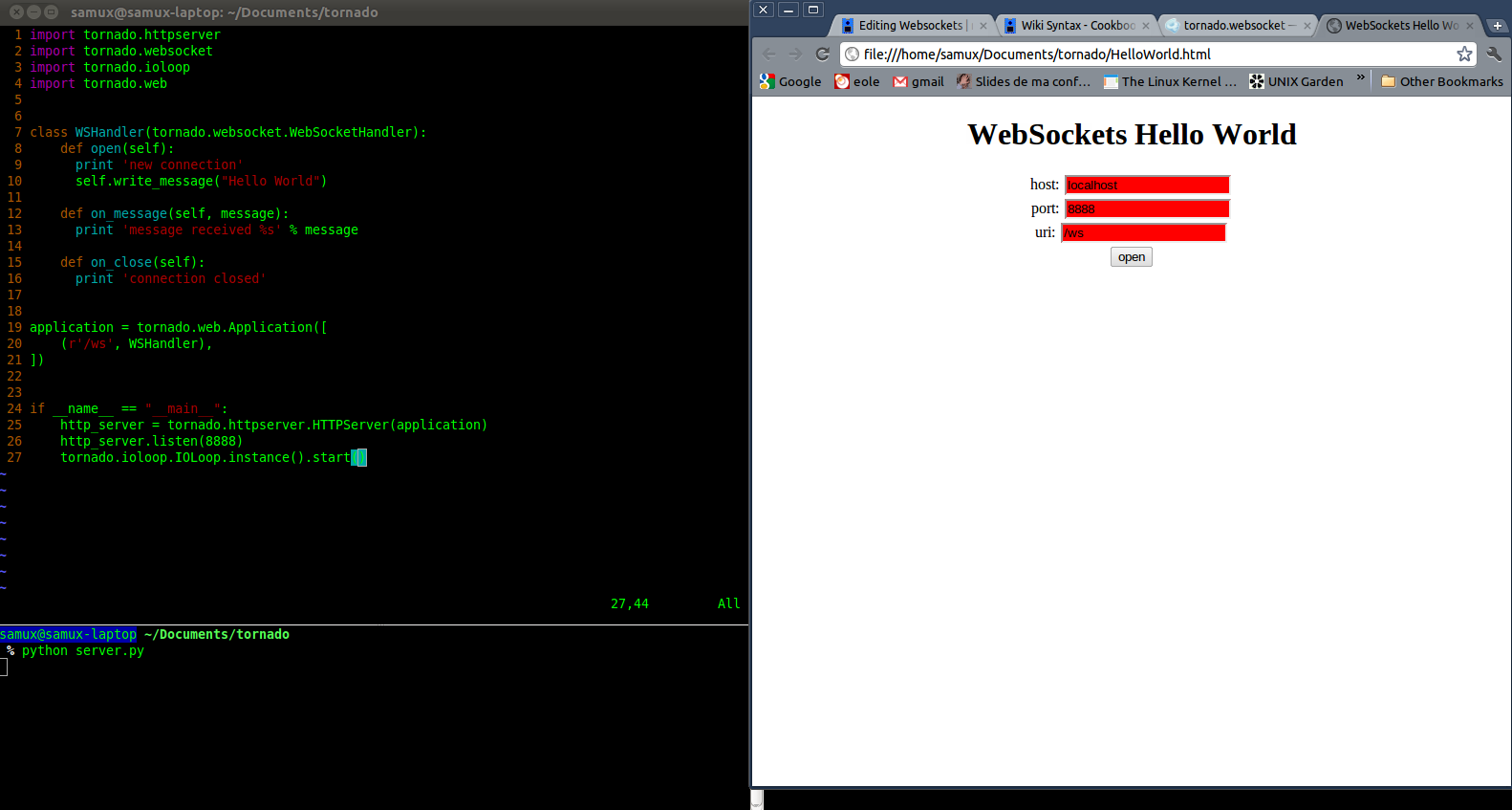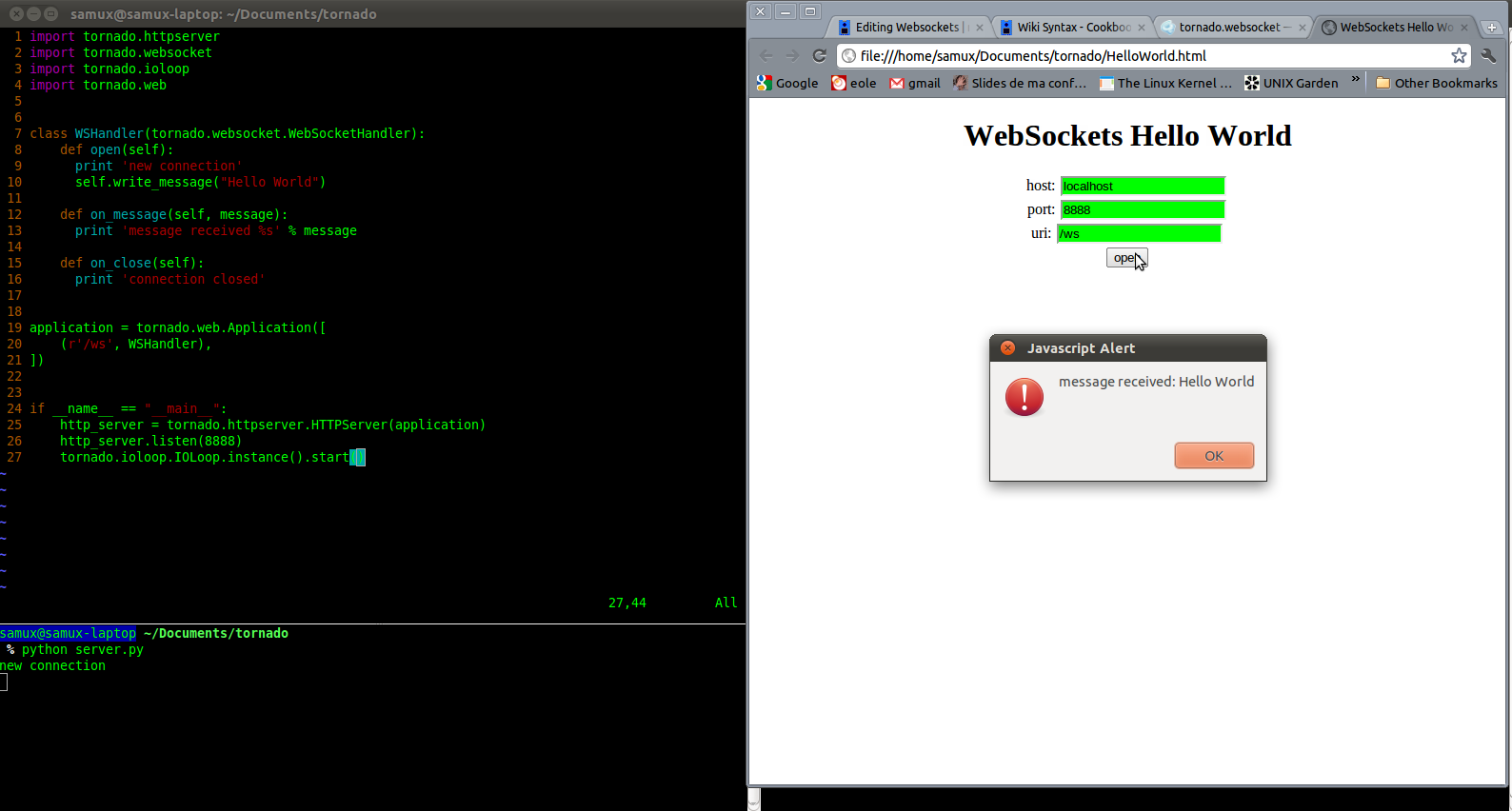You are viewing an older revision! See the latest version
Websockets
Websocket Tutorial¶
As explained in this webpage, a Websocket communication allows full-duplex, bi-directional communications between a server and clients.
To have a Websocket communication, we need a server. We chose Tornado Websocket server for the Internet of Things project. In this tutorial, I will present two servers: Tornado and Websocket4j.
This tutorial is divided in two parts:
- An Hello World which uses Tornado
- A streaming example which uses Websocket4j.
1 - Hello World!¶
1.1 - Server side: Tornado¶

Warning
Tornado is running on Unix-Like platform. If you are on Windows, choose another server.
Installation¶
- Download sources
$ tar xvzf tornado-2.0.tar.gz $ cd tornado-2.0 $ python setup.py build $ sudo python setup.py install
For more information concerning the installation, you can go here
Code¶
You can find all the documentation you need here but I will explain the main parts of the following basic Tornado Websocket server program.
The main idea is to define a class inherited from the WebSocketHandler class.
In this class, you can override the following methods:
- open
- on_message
- on_close
It's very simple, when a client and the server have performed the websocket handshake, the open method is called.
When a message is received from a client, the on_message method is called and if the connection is closed, the on_close method is called.
class WSHandler(tornado.websocket.WebSocketHandler):
def open(self):
print 'new connection'
self.write_message("Hello World")
def on_message(self, message):
print 'message received %s' % message
def on_close(self):
print 'connection closed'
In our case:
- when a connection is opened, the server prints "new connection" and sends to the client "Hello World"
- when a message is received, the server prints this message
- when a connection is closed, the server prints"connection closed"
To finish the server program, we have to start at the beginning of the program an HTTPserver which will listen on a certain port.
application = tornado.web.Application([
(r'/ws', WSHandler),
])
if __name__ == "__main__":
http_server = tornado.httpserver.HTTPServer(application)
http_server.listen(8888)
tornado.ioloop.IOLoop.instance().start()
An instance of tornado.web.Application is passed to the HTTPServer. When the server receives a request on the form:
var ws = new WebSocket("ws:localhost:8888/ws");, it will instantiate a WSHandler object. Note the "ws" at the end of the url. This will be useful for the client side implementation.
Finally, the whole program is:
import tornado.httpserver
import tornado.websocket
import tornado.ioloop
import tornado.web
class WSHandler(tornado.websocket.WebSocketHandler):
def open(self):
print 'new connection'
self.write_message("Hello World")
def on_message(self, message):
print 'message received %s' % message
def on_close(self):
print 'connection closed'
application = tornado.web.Application([
(r'/ws', WSHandler),
])
if __name__ == "__main__":
http_server = tornado.httpserver.HTTPServer(application)
http_server.listen(8888)
tornado.ioloop.IOLoop.instance().start()
1.2 - Client side¶
Warning
To follow this tutorial, you have to use a browser which supports websockets. Personnally, I use Chrome and there is no problem. You can do a test here to see if your browser supports websockets.
The main part of a simple Hello World can be: (if you are not familiar with jQuery, go here)
$("#open").click(function(evt) {
evt.preventDefault();
var host = $("#host").val();
var port = $("#port").val();
var uri = $("#uri").val();
ws = new WebSocket("ws://" + host + ":" + port + uri);
ws.onmessage = function(evt) {alert("message received: " + evt.data)};
ws.onclose = function(evt) { alert("Connection close"); };
ws.onopen = function(evt) {
$("#host").css("background", "#00ff00");
$("#port").css("background", "#00ff00");
$("#uri").css("background", "#00ff00");
};
});
- On this webpage, there are 3 fields: host, port and uri which have a red background at the beginning
- When the user has filled these 3 fields, he can try to open a websocket connection by clicking the open button
As for the server, there are three methods: onopen, onmessage and onclose:
- If the connection is opened, we change the background of the 3 previous fields to green
- When we receive a message, we open a pop-up containing the message received
- When the connection is closed, we open a pop-up containing Connection close
Finally, the whole program for the client is:
<!doctype html>
<html>
<head>
<title>WebSockets Hello World</title>
<meta charset="utf-8" />
<style type="text/css">
body {
text-align: center;
min-width: 500px;
}
</style>
<script src="http://code.jquery.com/jquery.min.js"></script>
<script>
$(document).ready(function () {
var ws;
$("#open").click(function(evt) {
evt.preventDefault();
var host = $("#host").val();
var port = $("#port").val();
var uri = $("#uri").val();
ws = new WebSocket("ws://" + host + ":" + port + uri);
ws.onmessage = function(evt) {alert("message received: " + evt.data)};
ws.onclose = function(evt) { alert("Connection close"); };
ws.onopen = function(evt) {
$("#host").css("background", "#00ff00");
$("#port").css("background", "#00ff00");
$("#uri").css("background", "#00ff00");
};
});
});
</script>
</head>
<body>
<h1>WebSockets Hello World</h1>
<div>
<label for="host">host:</label>
<input type="text" id="host" value="localhost" style="background:#ff0000;"/><br />
<label for="port">port:</label>
<input type="text" id="port" value="8888" style="background:#ff0000;"/><br />
<label for="uri">uri:</label>
<input type="text" id="uri" value="/ws" style="background:#ff0000;"/><br />
<input type="submit" id="open" value="open" />
</div>
</body>
</html>
1.3 - Demo¶


Et Voila, there is the pop-up on the client side containing Hello World and the backgrounds are green. On the server side, we see that a new connection has been opened.